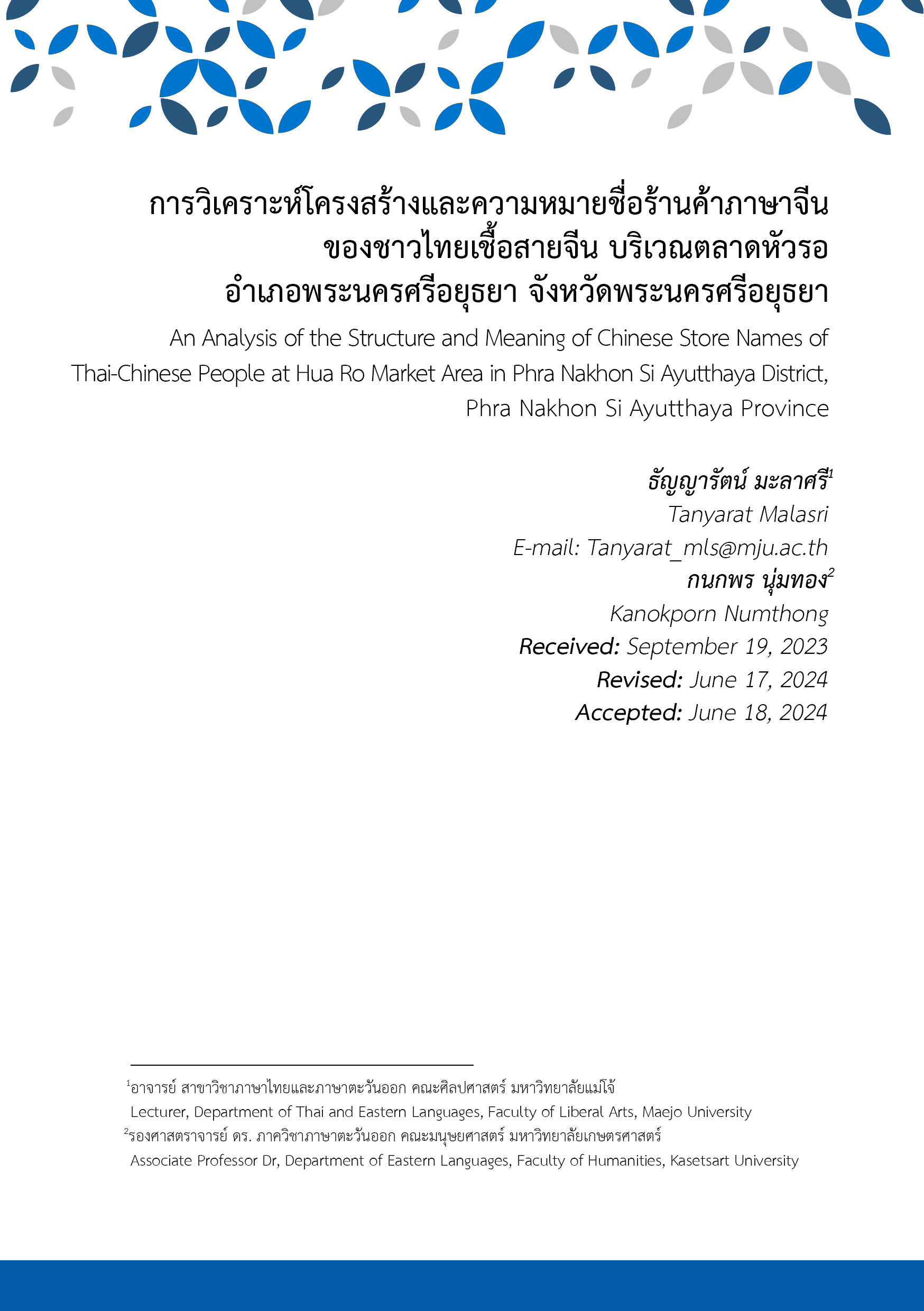An Analysis of the Structure and Meaning of Chinese Store Names of Thai-Chinese People at Hua Ro Market Area in Phra Nakhon Si Ayutthaya District, Phra Nakhon Si Ayutthaya Province การวิเคราะห์โครงสร้างและความหมายชื่อร้านค้าภาษาจีนของชาวไทยเชื้อสายจีน บริเวณตลาดหัวรอ อำเภอพระนครศรีอยุธยา จังหวัดพระนครศรีอยุธยา
Main Article Content
Abstract
This research paper aims to study the Chinese store names of Thai-Chinese people at Hua Ro market area in Ayutthaya. It emphasizes the structure and meaning of the store names including the data reflected on store signs and analyzes the data from all the collected Chinese store names around Hua Ro, Ayutthaya. The structure and meaning of Chinese store names at Hua Ro, Ayutthaya, can be categorized into 3 categories: 1) Forms and characteristics of the language, 2) Language aspects according to types of language structure, and 3) Information reflected by the names of Chinese stores. In terms of language forms and characteristics, Chinese store signs of Thai-Chinese people in Hua Ro Market Area, Ayutthaya, reveal the character types, character reading order, and character color. All of the store signs (100%) use traditional Chinese characters (繁体), and all of them (100 percent) read from right to left. Moreover, 95.34% of the signs are painted in yellow or gold because these colors represent good luck. In terms of language characteristics according to the types of language structure, we found that the signs use a single structure, composite structure, and other types of structure. The single-structure signs use only the family names the original form (25%) since the names are not complicated and they clearly indicate the identity of the shop owners. The most common family name used is “Lor” (罗) (18.42%) because many Chinese people with this family name settled down in this area. Grocery shop is the most common type of business (34.88%).
Downloads
Article Details

This work is licensed under a Creative Commons Attribution-NonCommercial-NoDerivatives 4.0 International License.
References
Chaiya, K., & Wiwatchot, K. (2015). Shrine and ethnic preservation of Thai-Chinese people in the area of the island of Ayutthaya. Ayutthaya: Phra Nakhon Si Ayutthaya Rajabhat University.
Champapan, K. (2016). Ayutthaya from an international port city society to a world heritage site. Bangkok: Museum Press Publishing House.
Karanyadech, Y., Phathairak, S., & Limbut, P. (2023). A Survey and Analysis of Chinese Shop Signs : A Case Study of the Chinese Community in Ranong Old Market. Social science journal Political Science, 7(2), 115-134.
Sikkakoson. (2008). Evolution of Chinese characters. Sinlapawatthanatham Journal. Retrieved from
https://www.silpamag.com/history/article_66873
Sikkakoson. (2023). Why? Teochew Chinese people like to trade more than do government work. Sinlapawatthanatham Journal. Retrieved from https://www.silpa-mag.com/history/article_82460
Sriman, K. (1976). Chinese society in Thailand. (Master's thesis). Royal Thai Army College, Bangkok.
Sodsongkrit, M. (2012). A survey and analysis of Chinese Shop Names among Chinese Thais in the area of Muang District, Ubon Ratchathani Province. Journal of Liberal Arts Ubon Ratchathani University, 8(2), 69-89.
Taengphan, P. (2014). Trade in Hua Ro Ayutthaya: From the River to the Road. Muang Boran Journal, 40(3), 33-45.
Thairath. (2021). Get to know the 5 Chinese clans, descendants of dragons in Thailand Revealing the origins of Chinese surnames. Thairath online. Retrieved from https://www.thairath.co.th/lifestyle/culture/2030525
Wamwanit, M. (2024). Why are Chinese characters written from top to bottom? Move the line from right to left, Learn Chinese with “Chinese language.com”. Retrieved from https://pasajeen.com/chinese-characters-left-to-right/
Wongthet, S. (2023). Ayothaya is older than Sukhothai. Origin of Ayutthaya, Rattanakosin prototype. Retrieved from https://www.silpa-mag.com/ history/article_106970
Yothinsirikul, S.(2020). A study of language on Chinese-Thai shop names in the Yaowarat community: A case study of Chinese and Thai Shop Names. Silpakorn University Journal, 21(1), 55-76.


